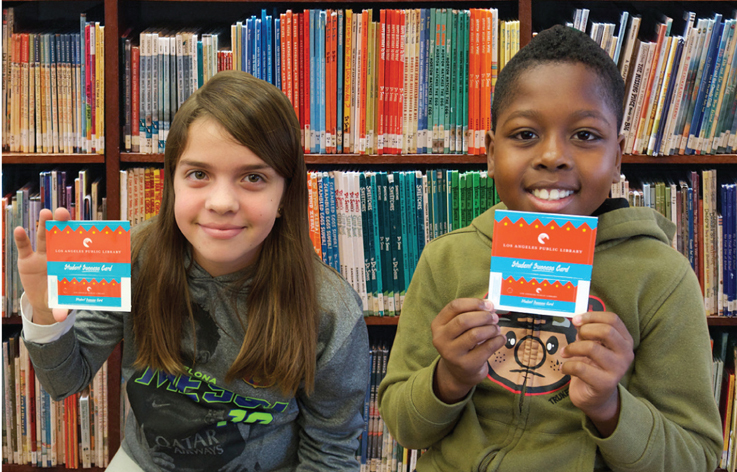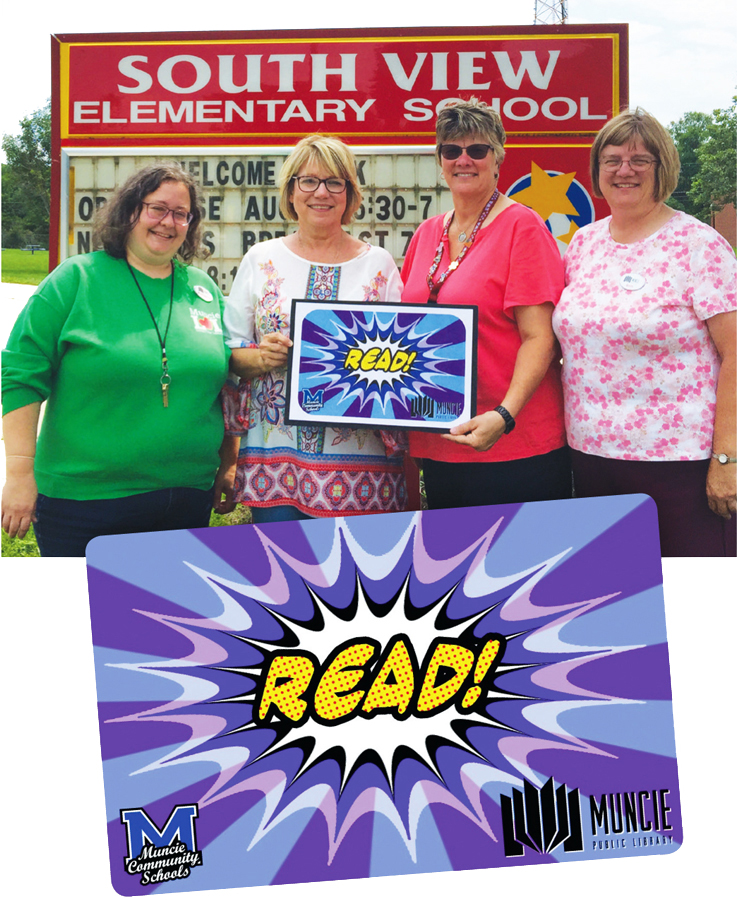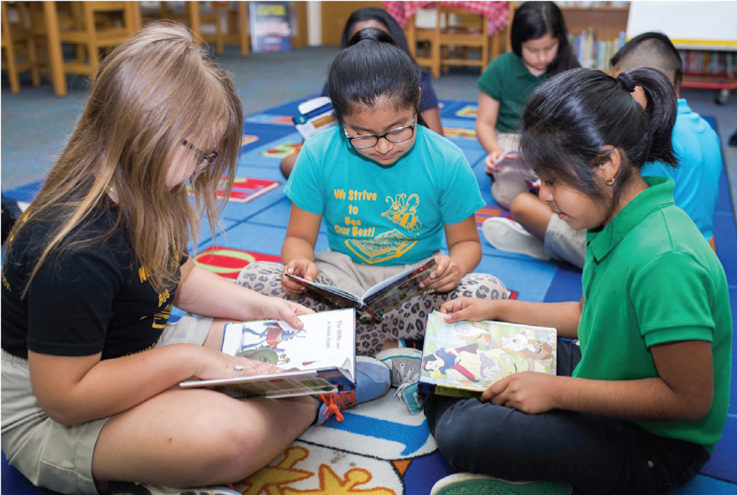Grade A Partnerships
Increasingly, public libraries have been finding creative ways to join forces with school administrators, librarians, and media specialists on collaborations that meet students’ evolving needs in and out of school. Clear lines of communication on both sides spell success for districtwide collaborations.
 Of the many challenges school libraries confront—meeting the need for instruction in multiple literacies in the face of contracting budgets, changing regulations, and more—the most basic remains the need to maintain inspiring, wide-ranging collections that serve a diverse student body, often across sizable school districts. Increasingly, public libraries have been finding creative ways to join forces with school administrators, librarians, and media specialists on collaborations that meet students’ evolving needs in and out of school.
Of the many challenges school libraries confront—meeting the need for instruction in multiple literacies in the face of contracting budgets, changing regulations, and more—the most basic remains the need to maintain inspiring, wide-ranging collections that serve a diverse student body, often across sizable school districts. Increasingly, public libraries have been finding creative ways to join forces with school administrators, librarians, and media specialists on collaborations that meet students’ evolving needs in and out of school.
Public libraries and schools have discovered innovative methods for sharing collections, providing access to materials and services, and getting library cards into the hands of students. Increasingly they have developed citywide policy around their partnerships, ensuring that the work they have begun will be ongoing and embedded in school and municipal civic culture.
Over the past few years, a number of these joint efforts have demonstrated not only imagination and replicable models but staying power. LJ looked at several such initiatives in “Public Partners” (LJ 3/15/17), and additional programs were surfaced at the LJ and School Library Journal summit “Stronger Together: Building Literacy-Rich Communities,” held May 10–12 in Omaha. At the two-day gathering, produced in partnership with Omaha Public Schools and the Omaha Public Library, key players discussed the challenges and rewards involved in several such citywide projects, offering a look at unexpected benefits, potential pitfalls, and best practices that public library and school partners can learn from and make their own.
Collaborative Roots
When it comes to durability, few alliances can beat the nearly 150 years of partnership between Indianapolis public libraries and schools. In the late 19th century, the city’s first school superintendent proposed that libraries provide reference materials for the schools. In 1879, small reference libraries were placed in 14 of the larger elementary schools. They proved so popular that the library was asked to provide them for all schools. This arrangement lasted until 1966, when a countywide public library was established and schools began to operate their own libraries.
In 1989, an anonymous donor bequeathed $24 million to Marion County college and high school libraries and the Indianapolis Public Library (IndyPL). With leadership from IndyPL and the former Indiana Cooperative Library Services Authority, county high schools began to link their catalogs to the public library’s. IndyPL placed terminals in all high school libraries, allowing students direct access to its catalog, and the collaboration that became today’s Shared System was born.
 |
|
CARDED Kids from the LA Public School System show off their Student Success cards while visiting |
Under the Shared System, school library items are cataloged, barcoded, and made searchable in the IndyPL catalog. School staff and students can see what’s available at IndyPL, their own school, and 291 public, private, charter, and parochial schools throughout the system, plus two local museums (cataloging for a third is in progress). They can access e-materials or request that physical items be delivered to their school or a library branch; a School Room Card lets teachers check out materials for an extended period. Public library users can borrow from school collections as well.
The public library provides cataloging for the Shared System, either generating new records or importing and cleaning up school libraries’ and museums’ existing records for a fee based on how thorough the school’s records are as well as annual administrative, system, and delivery charges. Rates are reasonable, though, and benefits to all members far outweigh costs. “One of our schools invited us to their employee health and wellness fair to exhibit,” Sarah Batt, Shared System manager at IndyPL, tells LJ, “because they see membership in a shared system as an employee benefit.”
Keeping the Channels Open
Resource sharing in Indianapolis may have deep roots, but until recently there was much room for improvement. Batt has worked with the program from both sides, including 12 years in the schools. Prior to her arrival at IndyPL in 2012, she says, what was missing was a strong communications pipeline. Discussion about the collaboration, she says, “was more about policies and loan periods and the nuts and bolts of our [integrated library system]. There wasn’t much information offered, if any, about programming or new resources that were coming online.”
Batt dove into what she calls “the care and feeding” of the Shared System, working to raise awareness among school faculty and administration of what it can bring them. She sends out a weekly newsletter, Friday Focus, that highlights system news, issues, and available resources. Every quarter Batt produces a circulation report, which also notes IndyPL items that have been sitting on school shelves longer than three weeks and need to get back into circulation.
This also answers a concern public library partners often hear from school librarians: their carefully built collections could leave the building and not be returned; during the 2017–18 school year, schools shared 31,910 items with one another and IndyPL patrons. But as they spend time within the Shared System, notes Batt, “they start to see how much comes in to their school to help their students and staff. Then that whole idea of territorialism starts to fall by the wayside.”
Susan Broman, Los Angeles Public Library (LAPL) acting assistant city librarian, has a ready answer for staff who express similar concerns about the half-million student library cards issued in partnership with the school district: “One, that would be amazing if so many students were coming to the library that our shelves looked empty. And two, the worst thing that would happen is that kids have books at home.”
Rolling with the Punches in Munchie
Keeping communication clear was critical to the partnership between the Muncie Public Library (MPL), IN, and Muncie Community Schools (MCS). Although the idea of a shared catalog was met with enthusiasm on both sides when then-director Virginia Nilles and the schools superintendent first began discussing it in 2015, shake-ups in the school system posed major challenges as the collaboration was beginning.
The school and library boards had signed an interlocal agreement to proceed with the project in May 2016. Of $40,000 in funding that the partnership requested, the Community Foundation of Muncie and Delaware County provided a grant for $20,000 in August, with MPL covering the additional $20,000; two elementary schools were brought into the shared catalog on a pilot basis. Motivate Our Minds, a local enrichment center with its own library, asked to be included as well.
 |
| PROUD PARTNERS (l.-r.): Muncie Public Library (MPL) content management coordinator Katherine Mitchell, Muncie Community Schools certified teacher librians Rhonda Cowan and Melinda Sheffield, and MPL assistant director Beth Kroehler with a mockup of the shared catalog Read! card. Photo by Nakilah Nosakahere |
In April 2017, the school system was named a distressed financial unit by Indiana’s Distressed Unit Appeals Board (DUAB), which brought in an emergency manager to take charge of the district’s struggling finances. The school board voted to close three elementary schools as part of the city’s deficit reduction plan. Four MCS librarians were terminated and two transitioned to teaching positions, leaving only two certified teacher librarians, Rhonda Cowan and Melinda Sheffield, to cover the entire nine-school system, with the help of aides.
Cowan and Sheffield were understandably wary of the initiative. “The media specialists were just told, ‘you’re meeting with the director at the library,’ and they didn’t have a clear understanding of what was going on,” says MPL content management coordinator Katherine Mitchell. “So at that first meeting they looked like deer in the headlights.”
“With all the upheaval that was going on in the school system at the time…our initial thought was, [MPL] is coming in to take our jobs,” Sheffield recalls. “The cafeteria workers had been outsourced, the custodians had been outsourced, the nurses, had been outsourced, so we thought, yep, we’re the next ones on the chopping block.”
Mitchell made it clear that the public library had no plans to interfere with their work and that they had control over what parts—and how much—of their collections they would share. “I would say, ‘It’s your collection; what do you want to do?’ ” The interlocal agreement was also worded in such a way that it gave Cowan and Sheffield full power to make decisions about the project alongside public library staff.
By the end of the 2016–17 school year, all six MCS elementary schools, two middle schools, and the high school had been brought into the project, along with Motivate Our Minds. Though when the aides were brought in to work in the school libraries, says Mitchell, “the media specialists had to do a lot of dedicated training…in order to bring them up to snuff on how things ran.... So it did stall our being able to share items for a few months.”
The system was up again by November 2017, however, and has run smoothly since. Each school’s catalog links to the shared catalog, and students’ cards work at both schools and MPL. Kids can also access databases; reading recommendation platforms such as TumbleBooks and NoveList are particularly useful, says Mitchell, as they can offer the aides help with readers’ advisory. As with Indianapolis’s Shared System, borrowing works in both directions.
Management of MCS has now been turned over to local Ball State University, which appointed a new school board in June. It has two years to present a plan to DUAB, says Mitchell, and anything could happen. “The partnership has to be ready to roll with the punches,” she adds. “You really can’t plan for the unexpected, but you need to have a plan in place for what to do when the unexpected happens.”
Cards in Every Classroom
Looking ahead was crucial when LAPL launched its Student Success Library Card in partnership with the Los Angeles Unified School District (LAUSD). The card originated from a conversation between City Librarian John Szabo and Mayor Eric Garcetti about ways the city could help LAUSD, a sprawling system of more than 1,300 schools that has seen overcrowding, low performance, and administrative problems over the past decade, as well as a sharp reduction in school librarians. Szabo suggested issuing an LAPL library card to every student.
Student privacy was one of the first questions all partners addressed. While schools and libraries both mandate protecting the privacy of their users, in the case of collaborations, each party needs to spell out its data-sharing model. The Family Education Rights and Privacy Act (FERPA) governs access to children’s education records within schools, but as Larra Clark, deputy director of the American Library Association (ALA) Office for Information Technology Policy, points out, many states have their own laws, policies, and practices around student privacy as well. (Clark recommends that library partners consult ALA’s Library Privacy Guidelines for Students in K–12 Schools.)
 |
| ALL TOGETHER NOW The Limitless Libraries collaboration strives to ensure that kids from Metro Nashville Public Schools are lifelong Nashville Public Library users. Photo by Mackenzie Grosser, NPL |
The library worked with a school district advocate, who in turn worked with LAUSD legal counsel to put together a conference call in which LAPL made its case. That both institutions shared privacy values was at the top of the list. “We went in saying, ‘here’s how important privacy of information is to us,’ ” says Broman, and the two drew up a data-sharing and privacy agreement satisfactory to both parties.
Because Los Angeles has one of the largest undocumented populations in the United States, physical privacy was a concern as well. The Student Success card doesn’t require children to provide a home address, and an early rollout of the card through the mail to students’ homes has since been replaced with in-school distribution—also in part because recipients tended to throw out the envelopes without opening them. Distribution created another layer of work for school administrations, says Broman, so LAPL tried to simplify the process as much as possible, paying the manufacturing company extra to bundle cards separately for each teacher.
LAPL decided early on not to charge late fees for materials checked out on the cards—students can take out up to three books or audiobooks at a time, as well as accessing e-resources, databases, and online homework tutoring. “We made the decision knowing that often one of the things that prevents a family from getting a library card in the first place is the fear of fines,” Broman tells LJ. The public library doesn’t charge for lost or damaged items either and is looking into allowing students to return library books to their school rather than a library branch. “We’re a really fortunate system,” Broman says. “We have good resources, thanks to Measure L that was passed in 2011.... Being able to use that ability to support a program like [Student Success] has been really important.”
The partners tested the first cards in fall 2016 and within nine months began to distribute them to students. Despite a turnover of four superintendents since the project began and the challenges of coordinating across the district’s huge sprawl, notes Broman, some 540,000 cards were issued in about two school years. Having the mayor’s office on board has been critical, she adds, and has opened doors across the district.
Indianapolis’s Batt seconds the sentiment: visionary leaders at the top can make all the difference to a collaboration—whether they’re in city government or school administration. “When a principal signs on and says, ‘I’m going into this whole hog. I want to make sure every single teacher in my school knows how to request materials,’ that makes it work,” she says.
A Common Language
Buy-in at the top has helped Limitless Libraries (LL), the collaboration between the Nashville Public Library (NPL) and Metro Nashville Public Schools, remain robust and thrive since it was founded in 2009. The program—which shares public library resources among more than 80,000 K–12 students and teachers in 123 city schools—was initiated by then-Mayor Karl Dean. But support for the initiative hasn’t wavered during the following two mayors’ tenures, says Stephanie Rodriguez, LL manager at NPL. “The program goes beyond any one person.”
NPL has begun installing self-checkout stations at schools, which will streamline students’ processes and help free up school librarians. Heading into the 2018–19 school year, LL wants to highlight the resources and privileges available for teachers, including the educator card that all teachers receive. Among other perks, NPL offers “curriculum kits”—collections of about 30 grade-appropriate materials on a particular subject that include fiction and nonfiction books, DVDs, and manipulatives—which can be checked out for a six-week period.
NPL is also looking at multigenerational use generated through the LL program, particularly by English-language learners, Rodriguez points out. “A student comes in and checks out materials and we realize that he or she is also checking out stuff that a little brother can read or that mom and dad can read.”
Another opportunity LL is considering is to extend the experience for students about to graduate. Some have been LL users for most of their school career, and Emily Farmer, LL collection development librarian at NPL, says, “We now have to find a way for them to continue as public library patrons,” possibly through a new type of library account or marketing targeted at graduating seniors.
Of deep importance to the LL program, says Farmer, has been NPL’s emphasis on creating a strong relationship with school librarians. “Having the school librarians understand what their students need, what their educators need—and being able to bring that back to us so we can tailor [LL] to what they actually need—has been the success of our program... Even nine years in, when they’re saying something is a problem, we’re still listening to them and making changes as needed.”
Muncie’s Mitchell stresses that both parties need to make the effort. “If you’re a public librarian and you want to reach out to the schools and you aren’t sure how to, you need to learn their language,” she says. “One speaks about things from the curricular point of view and the other side speaks about lifelong learning and 21st-century skills, but when you actually look at what that means, they really are intertwined.”
RELATED
ALREADY A SUBSCRIBER? LOG IN
We are currently offering this content for free. Sign up now to activate your personal profile, where you can save articles for future viewing









Add Comment :-
Comment Policy:
Comment should not be empty !!!